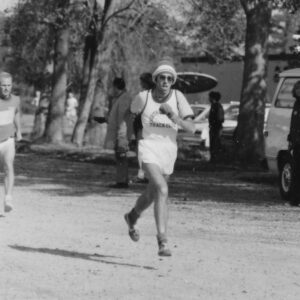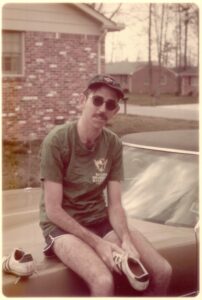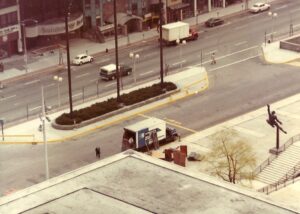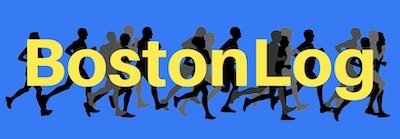First, a little background: My so-called road racing career began in fits and starts; but the initial date is easy to pin down: the day I read an article in the June 01, 1964, issue of Sports Illustrated about American expatriate Buddy Edelen. Unnoticed by most Americans, Edelen had run the first- and third-fastest marathons of all time, and had just returned from England to win the US Olympic marathon trial at Yonkers, New York, by over 20 minutes.
I was fascinated! I was amazed. I was inspired! So much so I put on my tennis shoes (literally my tennis shoes; who had a pair of running shoes back in 1964?), and headed out the door to run five miles for the first time in my life. In fact, to run further than 100 yards for the first time ever…
When I made the half way turn around at the extreme edge of my hometown, both the excitement and the adrenaline were already long gone; and by the time I got back home, I was dehydrated, physically spent, and had two feet that resembled raw meat, with blisters on top of blisters. I collapsed into bed and didn’t try to crawl out again until it was time to go back to school on Monday. But in spite of the experience, the running bug had bitten…

Act II: the North Carolina Track Club. In 1970, I was fortunate to fall in with an informal group of recent college distance runners hoping a support club would help them extend their racing careers. It came about this way: At the time, I was doing some running on the beach at Nags Head, North Carolina. Somehow I heard about a late summer ten mile beach run held on the Bogue Banks at Atlantic Beach, NC. The race course was billed as “downhill,” beginning at two feet elevation and going all the way down to sea level. What’s not to love about that! In addition, there was the opportunity afterwards to chow down at the Sanitary Fish Market, a quintessential seafood restaurant in nearby Morehead City.
A small but extremely fast field of less than 30 runners assembled at the finish line on the day of the race, to be transported ten miles down the beach by volunteers, so the race could be run point-to-point with the prevailing wind. Local runner Don Jayroe served as race director that year, and afterwards was criticized for making two major mistakes: First, Donnie had not properly consulted the local tide charts, and the race start time coincided with the incoming tide, so Atlantic Beach’s famed hard packed sand quickly disappeared under the waves, as runners were pushed further and further into the soft sand of the upper beach, making every step a Herculean effort. Secondly, Donnie was accused of measuring the course with an elastic string. In any case, the actual distance that day turned out to be eleven miles! And although it was out of Donnie’s control, runners actually faced a strong head wind the entire race. For someone who had barely trained to go ten miles, this combination of factors led to a very long afternoon. I thought I was in the race that would never end… However, at the end of the day, I discovered Donnie had done a great job of rounding up donations from local merchants as race prizes, which the winners chose on a first come, first served basis. When they got down to my 18th place, I was still able to score a nice nylon windbreaker, certainly a first for me in the awards department!
More importantly, I found this bunch of ex-collegians who dominated the race to be a very welcoming group, with several of them having as a realistic goal getting an invite to the upcoming U.S. Olympic Marathon Trial. When asked, I quickly joined their North Carolina Track Club, making a newsletter and all kinds of training advice available to me. They set a very high standard. Being on the edge of this circle of elite runners certainly expanded what seemed possible as goals, even for an obvious non-athlete like myself.

time to train while in the U.S. Army
Qualifying: My first trip to Boston began somewhere between a lark and a whim. My NCTC buddies kept encouraging me to up my training to try a marathon, and even in the pre-running boom days of the early 1970s, Boston had a definite appeal. A few years before, Boston had initiated a qualifying time, and for 1973, it was still set at 3:30 (that was the time for everyone, with no further breakdown by age groups). Anyway, around January 1st, I decided I was going to Boston. I was in the army at the time, serving in an oxymoron (i.e., “military intelligence”) unit in Maryland , so I had a little free time to train. When the Tidewater Striders announced they would sponsor a new marathon in Virginia Beach, the Rotary Shamrock Marathon on St. Patrick’s Day, I had a flat course close to home to run my first 26.2 mile race.

10th Place, 3:08:13

(Note the number of runners is matched only by the number of spectators...)

So, less than one month after my first marathon, I found myself among the milling throng in Hopkinton, anxious to begin a run towards Boston.
Ed Plowman, the North Carolina Track Club’s local “student in residence,” had provided transportation to save us from a liniment smell bus ride to the start. He also fixed me and several of my much more talented, but equally poor teammates, up with inexpensive accommodations in a Boston University dorm (although I recall being way too wound up to get any sleep). In addition to that, Ed had introduced us to the Durgin-Park dining experience, famous for its surly waitstaff back-talking the clientele.
I seem to remember something about everybody having to undergo a pre-race doctor’s exam at the high school gym, unless you had submitted a medical certificate from your own doctor. In the past four weeks, I had mostly recovered from my Virginia Beach race, but in no way had I been able to improve my training enough to expect a better result.
I was counting on our club’s racing glory to come from two other NCTC runners: Marshall Adams, who had posted multiple Boston top thirty finishes, including a 2:29:09 in 1970; and Jack Mahurin, who in his first Boston was destined to finish 12th.

Act III: The 77th Boston Marathon
“AS FOR THE RACE, if your left leg takes you 13 miles and your right leg does the other 13, all you have to worry about is only 385 yards!”
-The last item on the BAA’s “This is the only instruction sheet you will receive.”
Some vintage marathon humor – Q: How many starters will there be at this year’s Boston Marathon? A: One, the guy who fires the gun; the others are all just runners!
A decade earlier, Boston attracted less than 250 entrants. Today for the 77th running, 1,566 had signed up, with almost 1,400 showing up to join me at the start. Traditionally the race starts at high noon, so by 11:30 runners begin to queue up in a narrow, tree-lined side street named Hayden Rowe. Which meant once the gun sounded, you not only had to contend with the usual jostling within a big crowd, you had to position yourself to not get trampled during the sharp right-hand turn onto Main Street/ Route 135, a few hundred yards into the race. I survive this bottleneck and am on my way to “the PRU” – actually to “Quest Eternal,” the five ton bronze statue in front of the Prudential Center that has marked the Boston finish line since 1965, when the finish moved from the old BAA headquarters on Exeter Street…

For those not up on their Boston Marathon history, here is what I missed by not being up with the leaders: As expected, Finland’s Olavi Suomalainen, defending champion and pre-race favorite, held a comfortable lead after 17 miles, only to falter with heat cramps. Jon Anderson, a conscientious objector who is working as a hospital dishwasher in lieu of military service, overtook the Finn on Heartbreak Hill, and led from there to the finish. New Jersey’s fast closing Tom Fleming also moved ahead of the ailing Finn in the last five miles to take second place a minute behind Anderson. [At the finish line, Anderson hugs Fleming, exclaiming “Hey, Tom! One-two for America! That’s not bad!”]
I enjoy the early downhill nature of the course as I speed towards Ashland. I am baffled by the race check points, which come at funky distances: 6 ¾ miles, 10.5 miles, 13 ¾ miles, etc. They are of absolutely no use to me, but are one of those endearing features that make Boston Boston.
As we pass Wellesley College, I am fully feeling the effects of the day’s heat, and my race is already becoming a struggle. From deep within my growing “runner’s haze,” I think I hear someone call my name. I glance over to see an apparition of my buddy, Marshall Adams, who I assumed was now miles ahead of me. A nagging injury and the weather have been enough to convince Marshall to call it quits for the day. From all indications he has picked a good spot: with a cold beer in both hands, he was standing between two lovely Wellesley co-eds. What in-race hospitality!
Marshall spent some time socializing and watching the festivities, then walked over a few blocks to hitch a ride to town. He still managed to reach the finish area well before I did. Over the next thirteen miles, a constant thought is perhaps I should have joined him as a spectator at Wellesley…
Jack Mahurin always hoped for a hot day at Boston. He reasoned southern runners would be used to warm temperatures after their typical early spring training conditions, whereas all the local New England runners wouldn’t have been able to acclimatize to running in the heat. Before leaving home, Jack checked the warmer than average forecast for Greater Boston, and concluded “We’re going to Boston, and feast on some ‘Yankee stew’!” The strategy worked pretty well for Jack, as he finished in 12th place at 2:25:31. However, for me, as good as this strategy sounds in theory, in practice, not so much. By the mid afternoon, the temperatures are climbing to the unseasonable 80’s and the heat is becoming intense, just as I reach the Newton hills.
At the start of Heartbreak Hill, I hear a race official with a bull horn announce Jon Anderson of Eugene, Oregon, has won the laurel wreath in a time of 2:16:03. I have mixed emotions at this news. First, elation that for only the third time since World War II, an American had won the race. But also depression, that although the race has been won, I still have six plus miles remaining…

Near the top of Heartbreak Hill, I am starting to cramp up myself, and am in terrible need of some water, as aid stations are not in plentiful supply at Boston ’73. Running through a boisterous crowd of Boston College students, I gratefully grab at a young spectator’s offered cup, only to discover it is not the hoped for water, but an empty ice cream cup, complete with a wooden spoon. Failing to see the humor in this joke, I quickly discard it, and use the anger of the moment to propel myself over the crest of the hill.
Just after the crest of Heartbreak Hill, a view of the distant city comes into sight, and with it the famous large CITGO sign. In my gathering fog of fatigue, I can’t remember whether it’s one mile to go when you see the sign, or when you pass it. It’s soon evident it’s one mile when you pass it, and that point for me is still a long way away. I am very depressed…
And then I hear someone from the crowd call encouragement to me by name. Talk about a shot of adrenaline! But how can this be? The handful of people I know in Boston today are all in the race. And this total stranger has used my formal name “Haywood” and not my nickname “Woody,” something only my mother would have done. Then it comes to me, that back in the old days, the Boston Globe listed the name and number of every marathon entrant in the previous day’s edition of the newspaper. This guy had seen my number, quickly scanned the paper for my name, and called it out to me as I passed. I got quite a lift from being picked out of the crowd. I keep pushing for the distant finish line.
With several miles still to go until the end, at first very faintly, then increasing in volume, I begin to hear this roar of the crowd behind me. Gradually this crowd cheer becomes louder and closer. Then still louder, and even closer. Damn, I realize: It’s got to be the first woman! This can’t be happening! I dig deep into the tank for whatever energy might still be there. It is only enough juice for a 200 yard surge. Then up on my left comes this little sparkplug wearing F19 – It’s Jacki Hansen. She looks as wet and hot as I do, but is running so much smoother. Within her little bubble, the exuberance of the crowd is deafening. I try to stay with her, but I cannot hang on. The wave of urging and exhortations moves forward, as does the race leader on the female side. Ms. Hansen is destined to reach the finish three and a half minutes before I do.

The finish line 24 hours later
Finally I reach the much anticipated CITGO sign. Now it is the last mile. The traditional Patriots Day Red Sox baseball game must be over, as there are large numbers of folks mingling outside of Fenway Park (Tigers 9, Red Sox 7).
My finish is both a relief and a blur. My time is 3:09:28, with all that went wrong that day, only 75 seconds slower than my Virginia Beach time a month before. I find that encouraging…
In those days there were no T-shirts or participation medals for finishers (medals go only to the top 15 places – and they are hardly bigger than a thumbnail). A few weeks later a certificate will arrive in the mail, but on the day of the race, the only prize for finishers is the traditional bowl of beef stew. I know it’s expected, I make an attempt, but about two spoonfuls are all I can choke down after my stomach’s long afternoon in the heat.
As this is my first trip to Boston, I’ve planned to stay an extra day to do some sightseeing. My room at the Sheraton Boston tonight is $27.00 (plus $1.54 tax). What extravagance! Tuesday is a “three crowbar morning,” that being the number of crowbars it takes to pry me out of bed. I make the short walk back to the now very deserted finish line. I walk the sites of Boston’s Freedom Trail in the morning, having to go up or down stairs backwards whenever they are encountered. By afternoon I decide to head back to Fenway to watch some sit down baseball.
It’s not until much later I learn I have not only beaten “Love Story” author Erich Segal (who was toting a hefty portable microphone while he ran the race to record his live comments for TV), but also, in our first head to head to head match-up, I have beaten the later to be famous William Henry Rodgers himself! (in his first marathon ever, the future “Boston Billy” is a DNF, dropping out at 20 miles. “It was a torrid day,” Bill Rodgers later remarks…) Still, heading home on Wednesday, I already am able to take satisfaction in having helped America to a 1st, 2nd, and 358th place showing in its oldest and most prestigious road race.
Woody Harrell
Aberdeen Proving Ground, Maryland
Age 25
3:09:28
358th Place
[Woody Harrell also ran Boston in 1975 and 2014. Like 1973, these two races produced American winners, making Woody three for three as “America’s Good Luck Charm.”]
